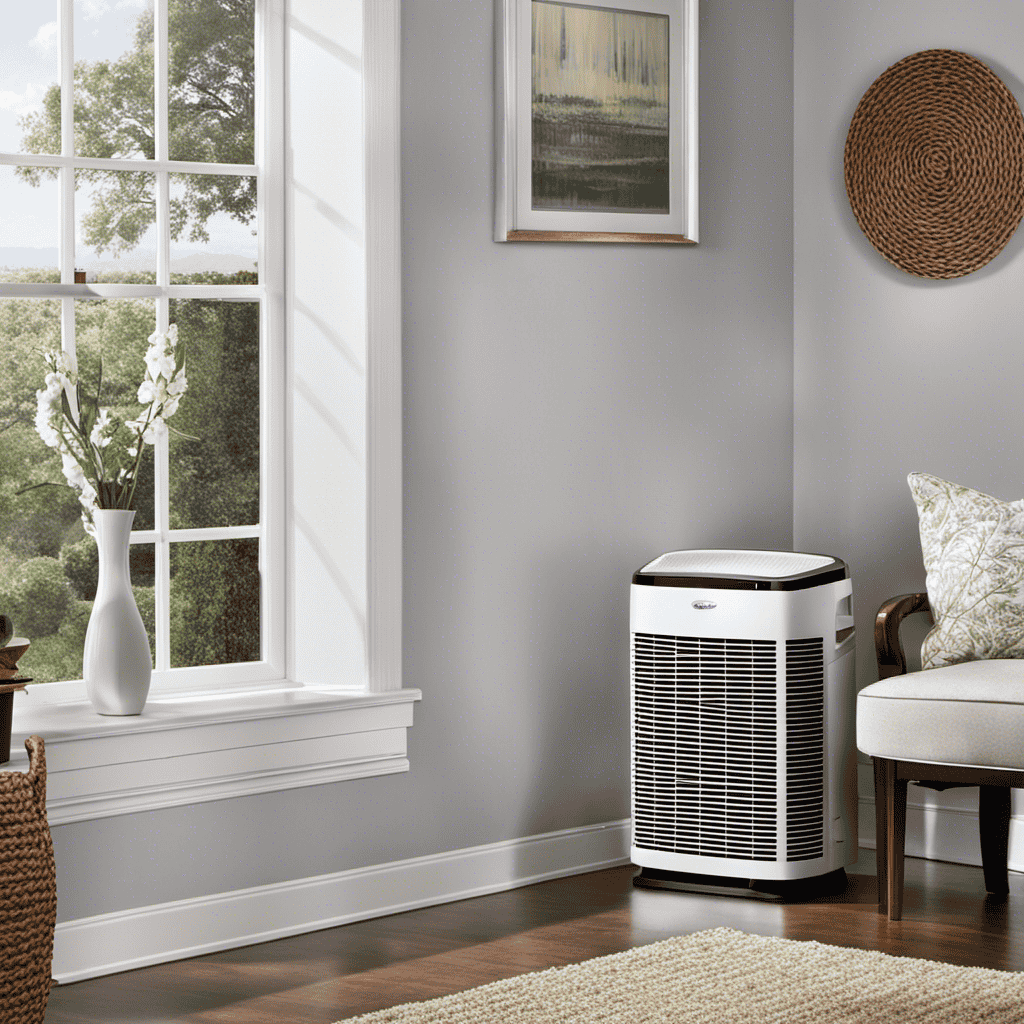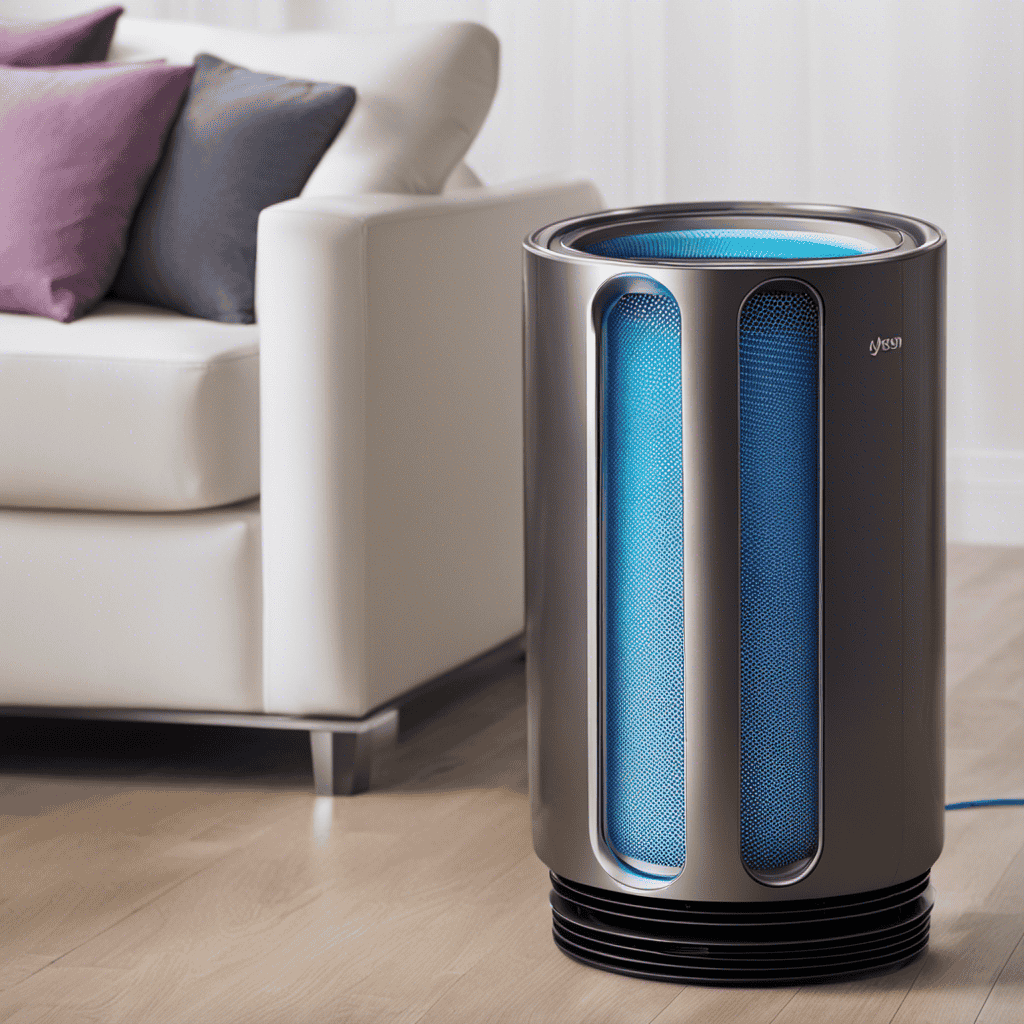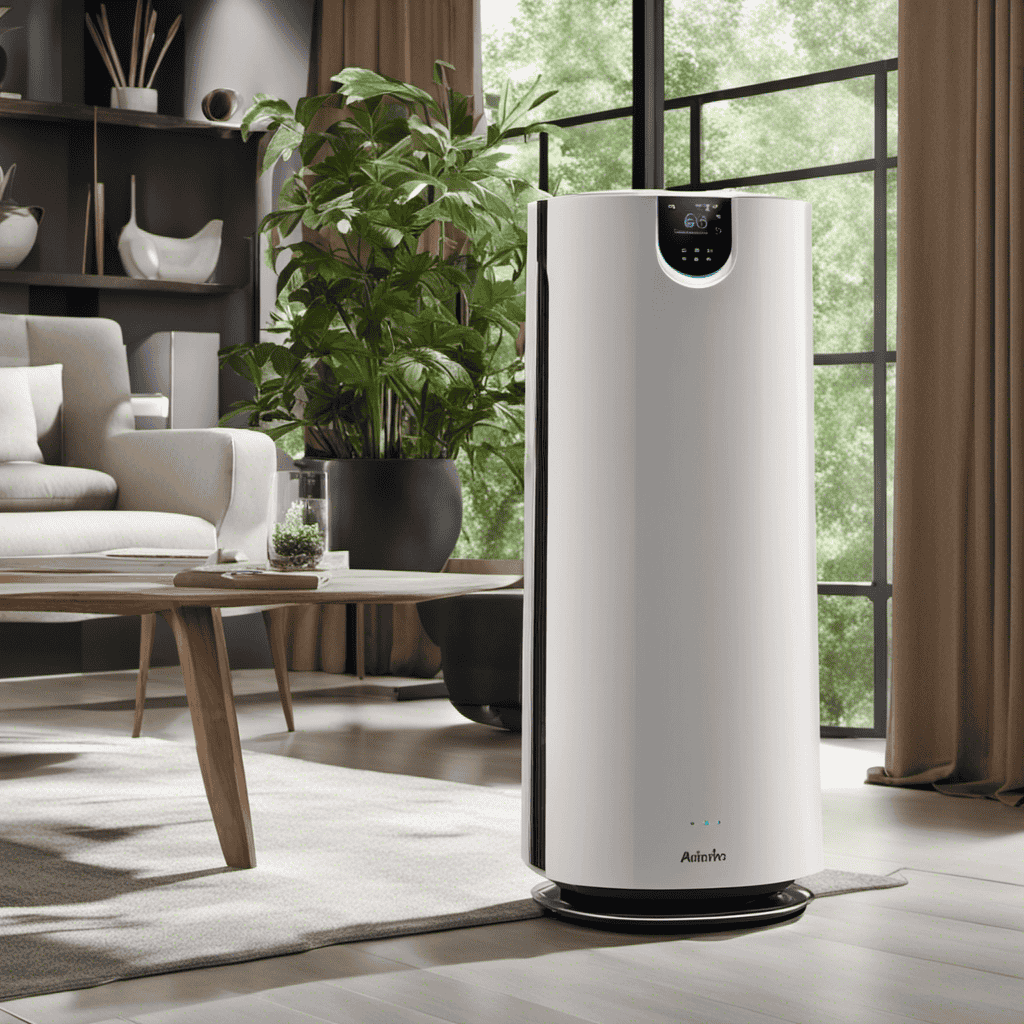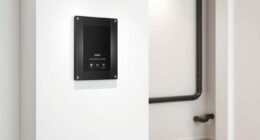Do you realize that the air in your home can be up to five times more contaminated than outdoor air? This is why I think it’s important for everyone to think about using an air purifier.
In this article, I will explore the benefits of having an air purifier, the common indoor air pollutants we face daily, and the health conditions that can benefit from using one.
I will also provide tips on how to choose the right air purifier for your needs and how to maintain its efficiency.
Key Takeaways
- An air purifier can improve indoor air quality and reduce allergies and respiratory issues.
- Common indoor air pollutants include dust mites, mold spores, volatile organic compounds (VOCs), pet dander, cigarette smoke, and pollen.
- Air purifiers can benefit those with allergies and respiratory conditions by filtering out allergens and improving indoor air quality.
- When choosing an air purifier, consider factors such as room size, filtration efficiency, noise level, and specific needs and budgets.
Benefits of Using an Air Purifier
Using an air purifier can greatly improve the air quality in your home and help reduce allergies and respiratory issues. Numerous studies have shown that these devices can effectively remove airborne particles such as dust, pollen, pet dander, and even mold spores from the air. By eliminating these pollutants, air purifiers can significantly reduce the risk of allergic reactions and asthma attacks.
One of the main concerns people have when considering an air purifier is the cost. While it is true that air purifiers can range in price, it is important to consider the long-term benefits they provide. Investing in a high-quality air purifier can result in improved health and well-being, which can ultimately lead to fewer medical expenses in the long run. Additionally, some air purifiers come with replaceable filters that need to be changed periodically. While this may add to the cost, the benefits of clean air far outweigh the expense.
Transitioning into the subsequent section about common indoor air pollutants, it is important to understand that even the cleanest homes can be filled with harmful substances that we may not be aware of.
Common Indoor Air Pollutants
To improve your indoor air quality, you should be aware of the common pollutants that can negatively impact your health. Allergies and respiratory illnesses are often triggered by these pollutants, so it’s important to understand what they are and how they can affect you.
One common indoor air pollutant is dust mites. These tiny creatures, along with their waste, can cause allergic reactions in many people. Symptoms include sneezing, coughing, and itchy eyes.
Another pollutant to be mindful of is mold. Mold spores can easily spread through the air and can cause respiratory issues, particularly in individuals with pre-existing conditions such as asthma.
Volatile Organic Compounds (VOCs) are another common pollutant found indoors. These chemicals can be emitted by various household products such as cleaning supplies, paints, and adhesives. Prolonged exposure to VOCs can lead to headaches, dizziness, and even damage to the liver and kidneys.
Indoor air pollution can also be caused by pet dander, cigarette smoke, and pollen. These pollutants can exacerbate allergies and respiratory illnesses, making it difficult to breathe and causing discomfort.
To improve your indoor air quality and reduce the risk of allergies and respiratory illnesses, it’s essential to regularly clean and vacuum your home, keep humidity levels in check, and ensure proper ventilation. Additionally, using air purifiers can help remove these common pollutants from the air, providing you with cleaner and healthier indoor air.
Health Conditions That May Benefit From an Air Purifier
Individuals with allergies or respiratory conditions can benefit from an air purifier by reducing the presence of common indoor pollutants. Allergies and respiratory diseases are often triggered by airborne particles such as dust mites, pet dander, pollen, and mold spores. These particles can cause irritation, coughing, sneezing, and difficulty breathing for those with sensitive airways. An air purifier can help alleviate these symptoms by filtering out these allergens and improving indoor air quality.
Numerous studies have shown the effectiveness of air purifiers in reducing allergens and improving respiratory health. For example, a study published in the Journal of Allergy and Clinical Immunology found that using air purifiers in bedrooms significantly reduced levels of indoor allergens and improved symptoms in allergic rhinitis patients. Another study published in the American Journal of Respiratory and Critical Care Medicine showed that air purifiers with HEPA filters reduced indoor particulate matter and improved lung function in asthmatic children.
Choosing the right air purifier for your needs can be overwhelming, but considering factors such as room size, filtration efficiency, and noise level can help you make an informed decision. In the next section, we will explore how to choose the right air purifier that suits your specific requirements and budget.
How to Choose the Right Air Purifier for Your Needs
When deciding on the right air purifier for you, it’s important to consider factors such as room size, filtration efficiency, and noise level. Air purifiers come with various features that cater to different needs.
For instance, if you have a large room, you’ll want to choose an air purifier that has a higher coverage area to effectively clean the air in that space. Filtration efficiency is another crucial factor to consider. Look for an air purifier that has a high CADR (Clean Air Delivery Rate) rating, as this indicates its ability to remove pollutants from the air efficiently.
Additionally, noise level should be taken into account, especially if you plan on using the air purifier in a bedroom or office where silence is preferred.
The importance of air quality cannot be overstated. Poor air quality can have detrimental effects on our health, leading to respiratory issues, allergies, and other health problems. An air purifier can help remove harmful pollutants such as dust, pet dander, pollen, and smoke from the air, improving the overall air quality in your home or office.
In the next section, we will discuss some tips for maintaining and maximizing the efficiency of your air purifier. These tips will help ensure that your air purifier continues to function effectively and provide you with clean, fresh air.
Tips for Maintaining and Maximizing the Efficiency of Your Air Purifier
One way to ensure your air purifier is working at its best is by regularly cleaning or replacing the filters. Proper maintenance not only improves the efficiency of the air purifier but also extends its lifespan.
Here are some tips to help you maintain and maximize the efficiency of your air purifier:
-
Clean or replace the filters: Filters trap and remove airborne particles, such as dust, pollen, and pet dander. Over time, these filters can become clogged and less effective. Cleaning or replacing them regularly will ensure that your air purifier is continuously removing pollutants from the air.
-
Vacuum the unit: Dust and debris can accumulate on the surface of the air purifier, affecting its performance. Regularly vacuuming the outside of the unit will help remove any dirt buildup and keep it running smoothly.
-
Keep the surroundings clean: Maintaining a clean environment around your air purifier is essential. Regularly dusting and vacuuming the room will minimize the amount of airborne particles and prevent them from entering the air purifier.
Frequently Asked Questions
Can Using an Air Purifier Completely Eliminate All Indoor Air Pollutants?
Using an air purifier can help reduce indoor air pollutants, but it may not completely eliminate them.
While air purifiers are effective at removing dust, pet dander, and pollen, they may not be as effective in eliminating bacteria and viruses.
It is important to note that the effectiveness of an air purifier depends on factors such as the size of the room and the type of purifier used.
Regular cleaning and proper ventilation are also crucial in maintaining clean indoor air.
Are All Air Purifiers Noisy and Disruptive to Daily Activities?
When it comes to air purifiers, one interesting statistic to note is that there are actually quiet air purifiers available on the market. This means that not all air purifiers are noisy and disruptive to daily activities.
Quiet air purifiers offer the benefits of using an air purifier, such as removing pollutants and allergens from the air, without the added noise. This is especially beneficial for those who need a peaceful and undisturbed environment.
Can an Air Purifier Help With Reducing Pet Dander and Allergies?
Reducing pet dander and allergies is a common concern for many people. An air purifier can help in improving indoor air quality by capturing pet dander and other allergens present in the air.
It works by filtering out these particles, effectively reducing the amount of allergens that you breathe in. This can lead to a decrease in allergy symptoms and overall improvement in respiratory health.
Therefore, for individuals dealing with pet allergies, an air purifier can be a beneficial addition to their living space.
Do Air Purifiers Remove Unpleasant Odors From the Air?
Yes, air purifiers are effective at removing unpleasant odors from the air. They work by using filters to capture and trap odor-causing particles and pollutants.
One interesting statistic is that a study published in the Journal of the Air & Waste Management Association found that air purifiers can reduce levels of volatile organic compounds (VOCs), which are often responsible for strong odors, by up to 90%.
This highlights the benefits of using an air purifier to improve indoor air quality and create a more pleasant living environment.
Can an Air Purifier Help With Reducing the Risk of Respiratory Illnesses in Children?
An air purifier can be effective in reducing the risk of respiratory illnesses in children. It helps to remove airborne pollutants such as dust, allergens, and bacteria, which can trigger respiratory problems.
Studies have shown that using air purifiers can improve indoor air quality and reduce symptoms of asthma and allergies.
While it may not completely prevent illnesses, it can certainly contribute to better respiratory health for children.
Conclusion
In conclusion, after careful analysis and consideration, it is evident that an air purifier is a valuable addition to any household. With its ability to remove common indoor air pollutants and alleviate health conditions, it becomes an essential tool for maintaining a clean and healthy environment.
However, the suspense lies in the question of who truly needs an air purifier. Is it only those with pre-existing health conditions or should everyone invest in this device? The answer remains uncertain, but the evidence strongly suggests that the benefits of using an air purifier extend beyond specific ailments, making it a worthwhile investment for all.










